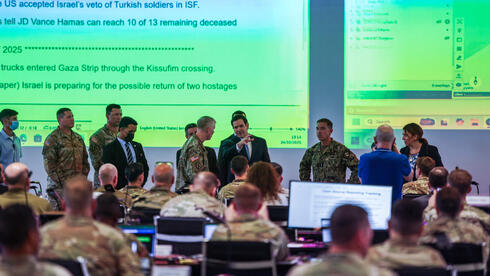For years, Israel’s greatest fear was that the conflict with the Palestinians would become international. That has now happened — quietly, over the past month, under the cover of the ceasefire and the Trump Plan, right under everyone’s noses in Kiryat Gat.


At the small American base, troops from France and Spain — two Western nations long known for their criticism of Israel — are now stationed. In response to claims that this represents a turning point, with Israel becoming a client state whose “new capital” is Kiryat Gat, Prime Minister Benjamin Netanyahu insists it is simply a joint command run with the United States.
U.S. Secretary of State Marco Rubio toured the site alongside IDF Maj. Gen. Yaki Dolf, Israel’s representative to the command and head of the Northern Corps. For anyone who saw the visit, the picture was clear: there is only one flag flying above the hangar, and it is not Israel’s. The Americans are in charge.
Alongside Israeli soldiers, many of them reservists, the base now hosts what one officer jokingly called “half the world’s armies” — troops from Germany, France, Australia, Greece, Britain, Jordan, the UAE and others. Representatives of civilian aid groups and the International Committee of the Red Cross are also present.
The base is overseen by U.S. Lt. Gen. Patrick Frank, with former U.S. Ambassador to Yemen Steve Fagin recently appointed by Rubio to manage the center’s civil-military coordination for the State Department.
Rubio called the work there “unprecedented.” “The work underway here is unprecedented,” he said. “This is a historic mission, and we have much to be proud of as we work toward long-term stability in Gaza.”
He said his visit focused on assessing the command’s needs and strengthening coordination of humanitarian and reconstruction efforts.
“Aid must be delivered without theft, and the stabilization force must be established before substantial reconstruction begins,” he said. “Multiple countries have expressed interest in participating in the force, though I will not specify which ones. No state will allow the involvement of Hamas in managing Gaza’s future security.”
In the large hangar that serves as the command’s operations floor, giant screens show live updates and open-source reports — footage of aid convoys, data on shortages of food, water, and medical supplies, and social media posts from Gaza. One report on Friday highlighted a UAE aid convoy crossing through Rafah.
The hangar’s walls are lined with synthetic turf to improve acoustics, and at its center hang two large posters detailing Trump’s 20-point plan for Gaza.
American officials describe the mission as minute-by-minute monitoring of developments in the Strip. Israeli officers say privately that this level of oversight effectively prevents Israel from resuming fire, even in response to continued violations by Hamas, which still holds the remains of 13 Israeli soldiers. “The American engine is in overdrive — they’re not stopping,” one senior Israeli source said.
Rubio said Washington remains committed to securing the return of all Israeli hostages and their remains.
“The integrity of the deal depends on both parties honoring their commitments,” he said. “Our broader objective is to create conditions in which the October 7 attacks can never be repeated — and where Israel can move forward with long-term security.”
The command center in Kiryat Gat has become the physical expression of international involvement in Gaza’s future — a partnership that Israel cannot easily step away from. The Americans lead, the allies follow, and Israel hosts.
In the coming days, Morgan Ortagus, the State Department’s representative to the United Nations and a member of the Lebanon ceasefire monitoring mechanism, is expected to visit the site as part of her mission in Israel. She will remain in the region until Monday before returning to Washington.
At the end of the week, U.S. Energy Secretary Chris Wright is due to arrive for consultations with Israeli officials, continuing a steady stream of American visitors to what has quietly become one of the most closely watched bases in Israel.
